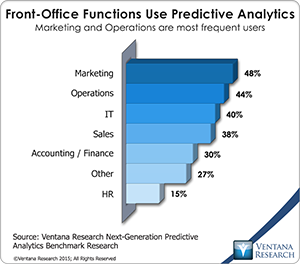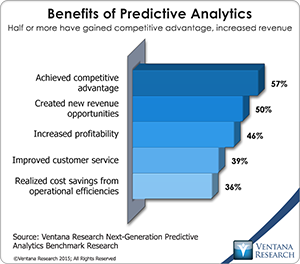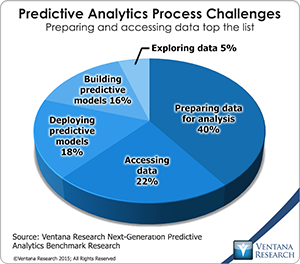Our benchmark research into predictive analytics shows that lack of resources, including budget and skills, is the number-one business barrier to the effective deployment and use of predictive analytics; awareness – that is, an understanding of how to apply predictive analytics to business problems – is second. In order to secure resources and address awareness problems a business case needs to be created and communicated clearly wherever appropriate across the organization. A business case presents the reasoning for initiating a project or task. A compelling business case communicates the nature of the proposed project and the arguments, both quantified and unquantifiable, for its deployment.
The first steps in creating a business case for predictive analytics are to understand the audience and to communicate with the experts who will be involved in leading the project. Predictive analytics can be transformational in nature and therefore the audience potentially is broad, including many disciplines within the organization. Understand who should be involved in business case creation a list that may include business users, analytics users and IT. Those most often primarily responsible for designing and deploying predictive analytics are data scientists (in 31% of organizations), the business intelligence and data warehouse team (27%), those working in general IT (16%) and line of business analysts (13%), so be sure to involve these groups. Understand the specific value and challenges for each of the constituencies so the business case can represent the interests of these key stakeholders. I discuss the aspects of the business where these groups will see predictive analytics most adding value here and here.
For the business case for a predictive analytics deployment to be persuasive, executives also must understand how specifically the deployment will impact their areas of responsibility and what the return on investment will be. For these stakeholders, the argument should be multifaceted. At a high level, the business case should explain why predictive analytics is important and how it fits with and enhances the organization’s overall business plan. Industry benchmark research and relevant case studies can be used to paint a picture of what predictive analytics can do for marketing (48%), operations (44%) and IT (40%), the functions where predictive analytics is used most.
and what the return on investment will be. For these stakeholders, the argument should be multifaceted. At a high level, the business case should explain why predictive analytics is important and how it fits with and enhances the organization’s overall business plan. Industry benchmark research and relevant case studies can be used to paint a picture of what predictive analytics can do for marketing (48%), operations (44%) and IT (40%), the functions where predictive analytics is used most.
A business case should show how predictive analytics relates to other relevant innovation and analytic initiatives in the company. For instance, companies have been spending money on big data, cloud and visualization initiatives where software returns can be more difficult to quantify. Our research into big data analytics and data and analytics in the cloud show that the top benefit for these initiatives are communication and knowledge sharing. Fortunately, the business case for predictive analytics can cite the tangible business benefits our research identified, the most often identified of which are achieving competitive advantage (57%), creating new revenue opportunities (50%), and increasing profitability  (46%). But the business case can be made even stronger by noting that predictive analytics can have added value when it is used to leverage other current technology investments. For instance, our big data analytics research shows that the most valuable type of analytics to be applied to big data is predictive analytics.
(46%). But the business case can be made even stronger by noting that predictive analytics can have added value when it is used to leverage other current technology investments. For instance, our big data analytics research shows that the most valuable type of analytics to be applied to big data is predictive analytics.
To craft the specifics of the business case, concisely define the business issue that will be addressed. Assess the current environment and offer a gap analysis to show the difference between the current environment and the future environment). Offer a recommended solution, but also offer alternatives. Detail the specific value propositions associated with the change. Create a financial analysis summarizing costs and benefits. Support the analysis with a timeline including roles and responsibilities. Finally, detail the major risk factors and opportunity costs associated with the project.
For complex initiatives, break the overall project into a series of shorter projects. If the business case is for a project that will involve substantial work, consider providing separate timelines and deliverables for each phase. Doing so will keep stakeholders both informed and engaged during the time it takes to complete the full project. For large predictive analytics projects, it is important to break out the due-diligence phase and try not to make any hard commitments until that phase is completed. After all, it is difficult to establish defensible budgets and timelines until one knows the complete scope of the project.
Ensure that the project time line is realistic and addresses all the key components needed for a successful deployment. In particular with predictive analytics projects, make certain that it reflects a thoughtful approach to data access, data quality and data preparation. We note that four in 10 organizations say  that the most time spent in the predictive analytics process is in data preparation and another 22 percent say that they spend the most time accessing data sources. If data issues have not been well thought through, it is next to impossible for the predictive analytics initiative to be successful. Read my recent piece on operationalizing predictive analytics to show how predictive analytics will align with specific business processes.
that the most time spent in the predictive analytics process is in data preparation and another 22 percent say that they spend the most time accessing data sources. If data issues have not been well thought through, it is next to impossible for the predictive analytics initiative to be successful. Read my recent piece on operationalizing predictive analytics to show how predictive analytics will align with specific business processes.
If you are proposing the implementation of new predictive analytics software, highlight the multiple areas of return beyond competitive advantage and revenue benefits. Specifically, new software can have a total lower cost of ownership and generate direct cost savings from improved operating efficiencies. A software deployment also can yield benefits related to people (productivity, insight, fewer errors), management (creativity, speed of response), process (shorter time on task or time to complete) and information (easier access, more timely, accurate and consistent). Create a comprehensive list of the major benefits the software will provide compared to the existing approach, quantifying the impact wherever possible. Detail all major costs of ownership whether the implementation is on-premises or cloud-based: these will include licensing, maintenance, implementation consulting, internal deployment resources, training, hardware and other infrastructure costs. In other words, think broadly about both the costs and the sources of return in building the case for new technology. Also, read my recent piece on procuring predictive analytics software.
Understanding the audience, painting the vision, crafting the specific case, outlining areas of return, specifying software, noting risk factors, and being as comprehensive as possible are all part of a successful business plan process. Sometimes, the initial phase is really just a pitch for project funding and there won’t be any dollar allocation until people are convinced that the program will get them what they need. In such situations multiple documents may be required, including a short one- to two-page document that outlines vision and makes a high-level argument for action from the organizational stakeholders. Once a cross functional team and executive support is in place, a more formal assessment and design plan following the principles above will have to be built.
Predictive analytics offers significant returns for organizations willing pursue it, but establishing a solid business case is the first step for any organization.
Regards,
Tony Cosentino
VP and Research Director












